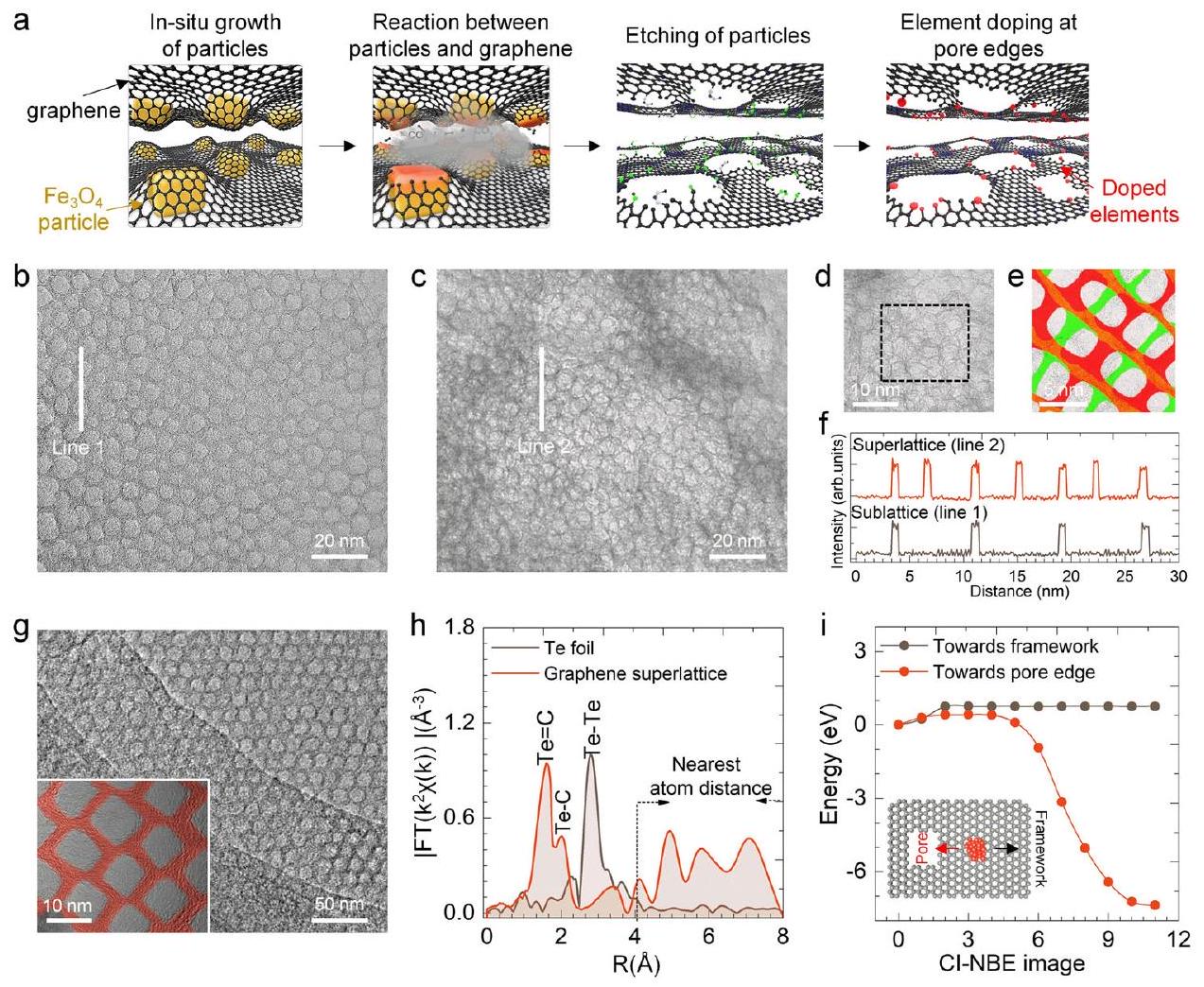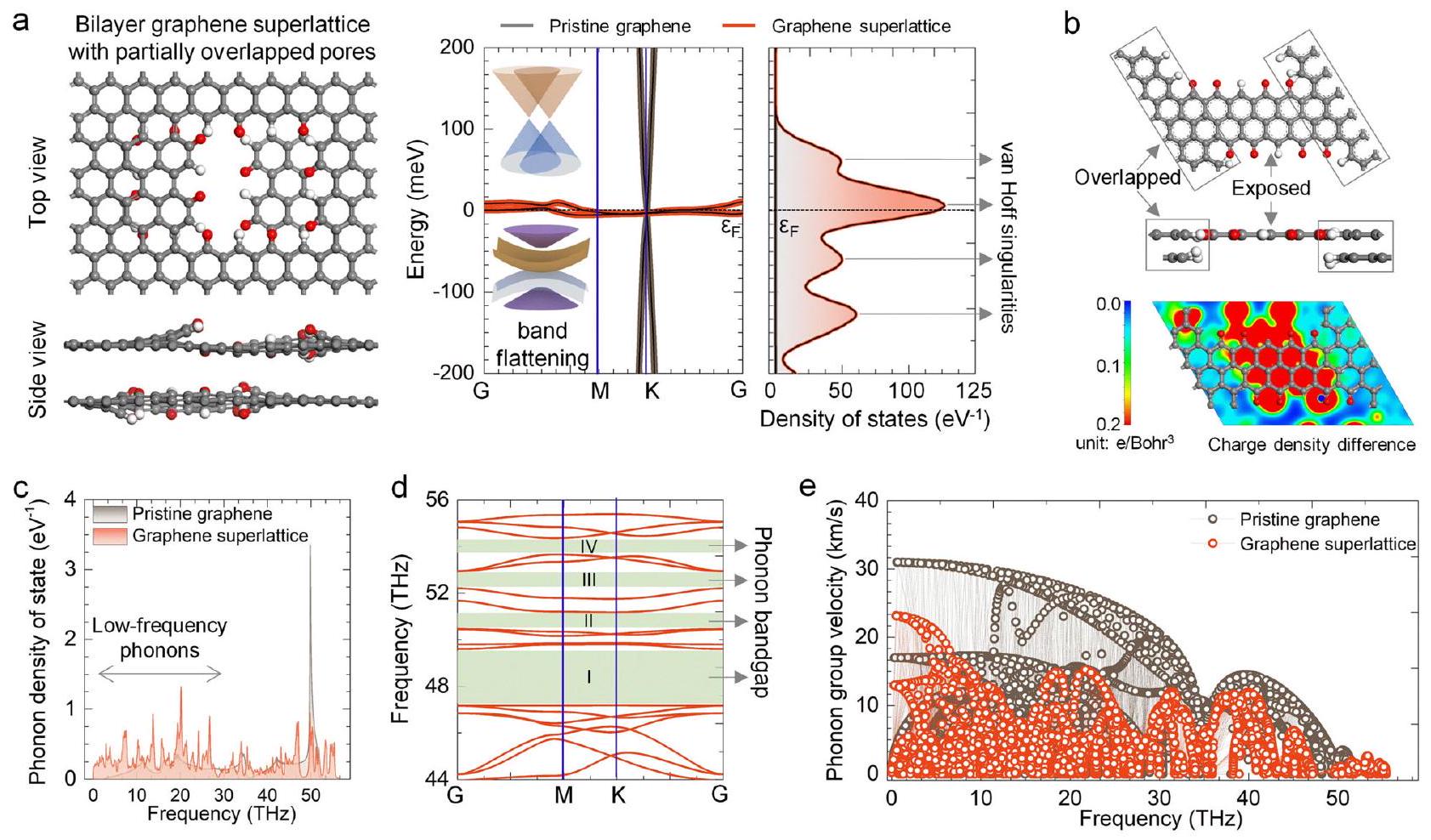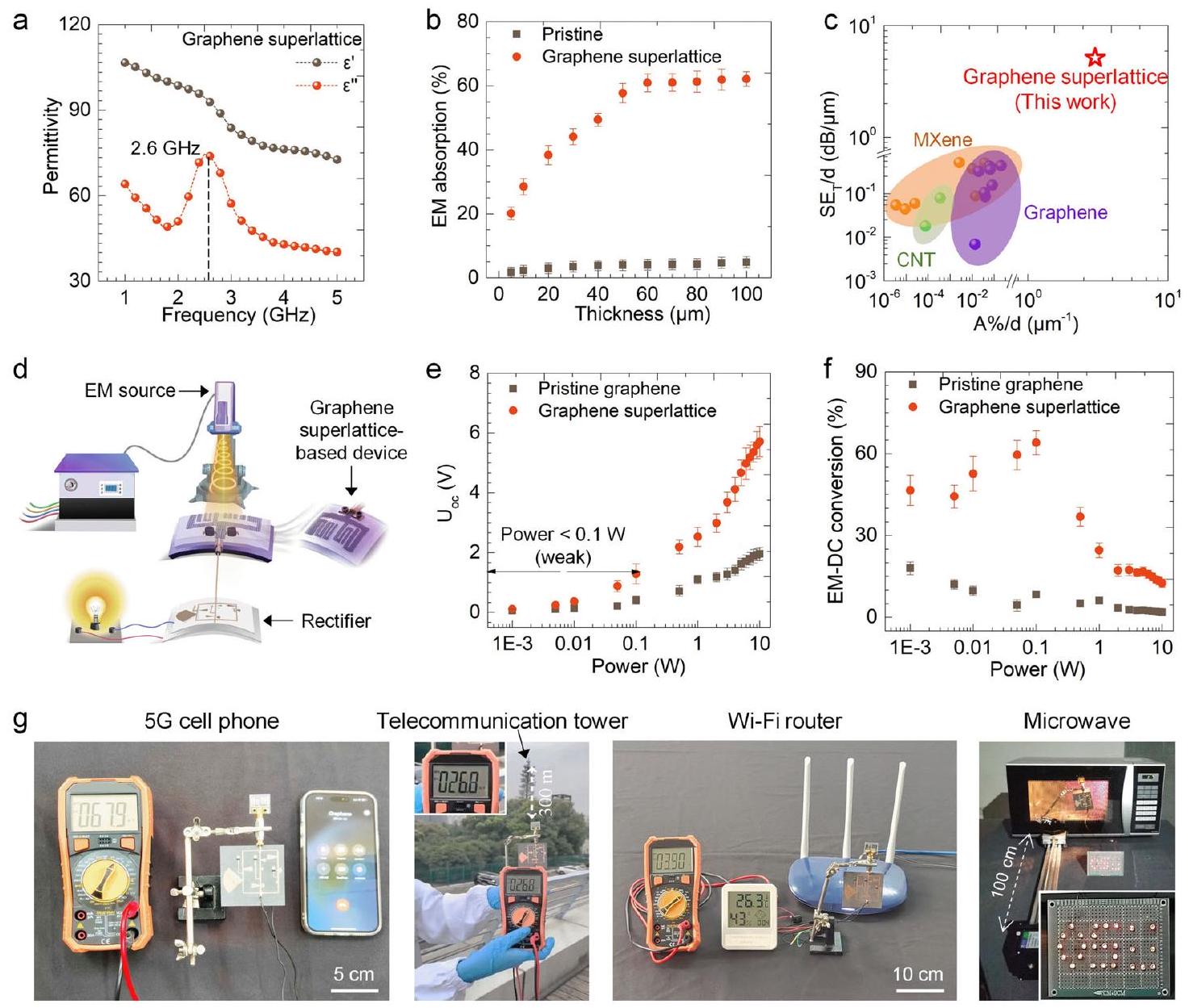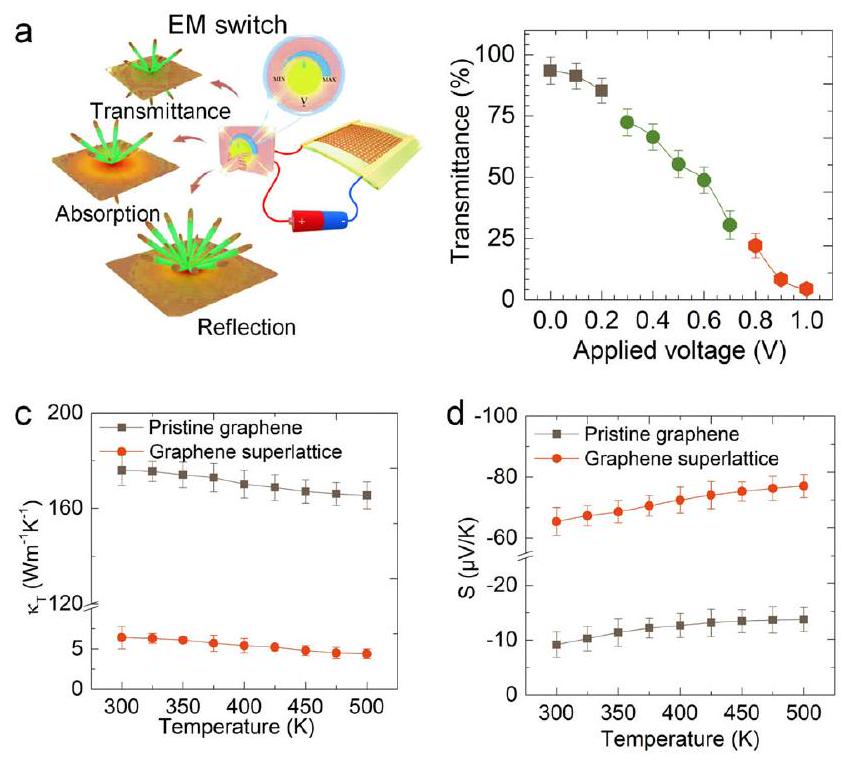DOI: https://doi.org/10.1038/s41467-024-45503-9
PMID: https://pubmed.ncbi.nlm.nih.gov/38346953
تاريخ النشر: 2024-02-12
الشبكة الفائقة الجرافينية النانوية المسامية الوظيفية
تم القبول: 26 يناير 2024
نُشر على الإنترنت: 12 فبراير 2024
(ت) تحقق من التحديثات
الملخص
لقد ظهرت السوبرلاتيس ثنائية الأبعاد (2D)، التي تتكون من تكديس تحت الشبكات لمواد ثنائية الأبعاد، كمنصة قوية لتعديل وتعزيز خصائص المواد بما يتجاوز خصائصها الجوهرية. ومع ذلك، فإن طرق التخليق التقليدية محدودة بالشبكات الفرعية لمواد ثنائية الأبعاد النقية، مما يشكل تحديًا عمليًا كبيرًا عندما يتعلق الأمر بتكديس الشبكات الفرعية المعدلة كيميائيًا. هنا، نبلغ عن طريقة تخليق كيميائية تتغلب على هذا التحدي من خلال إنشاء سوبرلاتيس جرافين ثنائية الأبعاد فريدة، حيث يتم تكديس الشبكات الفرعية للجرافين مع مسام مربعة الشكل بحجم نانومتر وحيدة التوزيع وعناصر مشوبة بشكل استراتيجي عند حواف المسام. تظهر السوبرلاتيس الناتجة من الجرافين ارتباطات ملحوظة بين الأطوار الكمومية على كل من مستويات الإلكترون والفونون، مما يؤدي إلى وظائف متنوعة، مثل درع الكهرومغناطيسية، وجمع الطاقة، والإلكترونيات الضوئية، والإلكترونيات الحرارية. بشكل عام، لا توفر نتائجنا فقط مبادئ التصميم الكيميائي لتخليق وفهم السوبرلاتيس ثنائية الأبعاد الوظيفية، بل توسع أيضًا من وظيفتها المعززة وإمكانات تطبيقها الواسعة مقارنة بنظيراتها النقية.
درجات عدم المحاذاة
الطبقات الفائقة من خلال تكديس المواد ثنائية الأبعاد المسامية، مما يمهد الطريق لتصميم طبقات فائقة ثنائية الأبعاد بخصائص قابلة للتعديل ووظائف غير مسبوقة مقارنةً بنظيراتها النقية.
النتائج
تركيب سوبرلاتيس الجرافين المسامي

 سوبرلattice الجرافين. تمثيل تخطيطي لعملية تخليق سوبرلattice الجرافين. تتضمن العملية لإنشاء سوبرلattice الجرافين المدعوم بالعناصر زراعة جزيئات أكسيد الحديد على الجرافين، تليها حفر الكربون، وإزالة الجزيئات النانوية باستخدام حمض الهيدروكلوريك، وتدعيم العناصر في سوبرلattice الجرافين. صور مجهرية إلكترونية ناقلة تظهر (ب) سوبرلattice الجرافين أحادي الطبقة مع مسام نانوية مربعة الشكل متجانسة الحجم و(ج-هـ) سوبرلattice الجرافين ثنائي الطبقة مع مسام نانوية مربعة الشكل متداخلة جزئيًا. الطبقات العليا والسفلى في سوبرلattice الجرافين في (هـ) هي
سوبرلattice الجرافين. تمثيل تخطيطي لعملية تخليق سوبرلattice الجرافين. تتضمن العملية لإنشاء سوبرلattice الجرافين المدعوم بالعناصر زراعة جزيئات أكسيد الحديد على الجرافين، تليها حفر الكربون، وإزالة الجزيئات النانوية باستخدام حمض الهيدروكلوريك، وتدعيم العناصر في سوبرلattice الجرافين. صور مجهرية إلكترونية ناقلة تظهر (ب) سوبرلattice الجرافين أحادي الطبقة مع مسام نانوية مربعة الشكل متجانسة الحجم و(ج-هـ) سوبرلattice الجرافين ثنائي الطبقة مع مسام نانوية مربعة الشكل متداخلة جزئيًا. الطبقات العليا والسفلى في سوبرلattice الجرافين في (هـ) هيمتميز بالأحمر والأخضر، على التوالي.
(الشكل 1f). لفحص تأثير تكديس الشبكات الفرعية غير المتراصة، قمنا بتخليق الجرافين مع مسام نانوية متداخلة تمامًا (الشكل 1g). تعتبر المسطحات العالية للجرافين، ومجموعة كثيفة من الهياكل النانوية ذات الحجم المتجانس، ومدة تفاعل تقليل الكربون المثلى ضرورية لإنشاء مسام نانوية مرتبة. يُعزى التشوه أو التوزيع المتعدد في المسام النانوية إلى الظروف غير المثلى أو القوالب غير المنتظمة (الأشكال التكميلية 3 و4). هنا نشير إلى الجرافين ثنائي الطبقة مع مسام مربعة متداخلة جزئيًا باسم الجرافين السوبرلattice.
الهيكل الإلكتروني والصوتي للسوبرلattice الجرافيني

كتلة لانهائية وزيادة في تفاعل كولوم بين الإلكترونات، مما يساهم في تسطيح الشريط المعزز. تدعم هذه التحليلات الحسابية قياسات تركيز حامل هول، مما يكشف عن زيادة تقريبية بنسبة
تعديل الموجات الكهرومغناطيسية للسوبرlattice الجرافيني
من كل من المناطق الكربونية المتداخلة والمكشوفة. يبدأ هذا إعادة التكوين بإنشاء جدران مجال الإلكترون، مما يؤدي إلى احتجاز إلكترونات فيرمي على كلا الجانبين وتوليد فرق جهد بين السطوح المجاورة. عند تعرضها لحقول كهرومغناطيسية معدلة، يعيد هذا الجهد توجيهه ديناميكيًا استجابةً للمجال الكهربائي المعدل، مما يؤدي إلى سلوك استرخاء الاستقطاب. يتميز هذا السلوك الاسترخائي بانخفاض حاد في السماحية الحقيقية (
تطبيقات موسعة لشبكة الجرافين الفائقة

شبكة فائقة. سماحية تعتمد على التردد لشبكة الجرافين الفائقة.
b كفاءة امتصاص الموجات الكهرومغناطيسية (EM) المعتمدة على السمك لثنائي طبقات الجرافين النقي وسوبرلاتيس الجرافين. تمثل أشرطة الخطأ الانحرافات المعيارية من ثلاث قياسات مستقلة على نفس العينات الفيزيائية. ج مقارنة فعالية درع EM (
البصريات، الإلكترونيات، والعلوم الحرارية (انظر الملاحظة التكميلية 7 للارتباطات التفصيلية). أولاً، تظهر السوبرلاتيسات الجرافينية العديد من التفردات المتتالية لفان هوف بالقرب من مستوى فيرمي (الشكل 2أ). قمنا بتطوير نافذة ذكية لموجات EM تعتمد على السوبرلاتيس الجرافيني، والتي يمكن أن تنقل، وتمتص، وتحمي من موجات EM بشكل انتقائي من خلال تطبيق جهد منخفض يصل إلى 1.0 فولت (الشكل 4أ). ثانياً، في السوبرلاتيس الجرافيني، يؤدي زيادة انقسام مستوى الطاقة والفروق المحتملة عبر جدار المجال الإلكتروني إلى فصل الإلكترونات والثقوب، مما يسبب تأثير فوتولومينيسنس ملحوظ ضمن نطاق طول موجة الضوء المرئي.
انخفاض في الموصلية الحرارية العامة، كما هو موضح في الشكل 4c، الشكل التوضيحي 27 والملاحظة 8. تتراوح هذه الموصلية الحرارية بين


نقاش
طرق
مواد
تخليق السوبرلات الجرافينية
بعد التشتت في السيكلوهكسان والإيزوبروبانول. تم إخضاع الجرافين الناتج المغطى بجزيئات
تخليق الجرافين مع مسام متداخلة بالكامل
, و Se عند حواف المسام للجرافين من خلال التحلل الحراري عند درجات حرارة مختلفة (الجدول التكميلي 2).
إشعاع (طول موجي 0.15406 نانومتر). تم التحقيق في شكل الجسيمات النانوية والجرافين المسامي باستخدام مجهر إلكتروني نافذ (TEM) من نوع Joel JEM 2100 F مع انبعاث ميداني 200 كيلوفولت. تم إجراء تحليلات طيفية للأشعة السينية باستخدام جهاز Escalab 250Xi. تم تقييم جودة الجرافنة باستخدام جهاز Jobin Yvon HR 800 لرصد رامان التداخلي. تم إجراء تحليل هيكل امتصاص الأشعة السينية القريب من الحافة (XANES) في Beamline 33BM-C في قسم XOR لمصادر الفوتون المتقدمة. تم إجراء قياسات امتصاص الأشعة السينية الممتدة في beamline 7-BM من مصدر الضوء الوطني II، مختبر بروكهافن الوطني. تم إجراء تحليل الروابط الكيميائية للجرافين باستخدام جهاز Nicolet iS50 لطيف الأشعة تحت الحمراء بتحويل فورييه (FT-IR). تم تسجيل أداء الفوتولومينيسنس في درجة حرارة الغرفة باستخدام جهاز LifeSpec II لقياس عمر الفلورسنت
المزود بجهاز ليزر ثنائي ينبعث عند طول موجي 365 نانومتر. تم قياس الانبعاثية تحت الحمراء باستخدام جهاز PerkinElmer Spotlight 200i FT-IR مع كرة تكاملية للأشعة تحت الحمراء.
بسبب التغيرات الناتجة عن نعومة أسطح العينات.
هو درجة الحرارة.
References
- Zhou, J. et al. Heterodimensional superlattice with in-plane anomalous hall effect. Nature 609, 46-51 (2022).
- Cao, Y. et al. Unconventional superconductivity in magic-angle graphene superlattices. Nature 556, 43 (2018).
- Chen, D. et al. Excitonic insulator in a heterojunction moiré superlattice. Nat. Phys. 18, 1171-1176 (2022).
- Septianto, R. et al. Enabling metallic behavior in two-dimensional superlattice of semiconductor colloidal quantum dots. Nat. Commun. 14, 2670 (2023).
- Chen, P. et al. Chemical synthesis of two-dimensional atomic crystals, heterostructures and superlattice. Chem. Soc. Rev. 467, 3129 (2018).
- Pantaleon, P. A. et al. Superconductivity and correlated phases in non-twisted bilayer and trilayer graphene. Nat. Rev. Phys. 5, 304-315 (2023).
- Zhang, Z. W. et al. Robust epitaxial growth of two-dimensional heterostructures, multi-heterostructures, and superlattices. Science 357, 788 (2017).
- Zhang, S. et al. Domino-like stacking order switching in twisted monolayer-multilayer graphene. Nat. Mater. 21, 621 (2022).
- Geuchies, J. J. et al. In-situ study of the formation mechanism of two-dimensional superlattices from PbSe nanocrystals. Nat. Mater. 15, 1248 (2016).
- Huang, T. Y. et al. Observation of chiral and slow plasmons in twisted bilayer graphene. Nature 605, 63 (2022).
- Shen, C. et al. Dirac spectroscopy of strongly correlated phases in twisted trilayer graphene. Nat. Mater. 22, 316 (2023).
- Merida, J. D. et al. Symmetry-broken josephson junctions and superconducting diodes in magic-angle twisted bilayer graphene. Nat. Commun. 14, 2396 (2023).
- Zhang, Y. et al. Every-other-layer dipolar excitons in a spin-valley locked superlattice. Nat. Nanotechnol. 18, 501 (2023).
- Chio, S. H. et al. Large-scale synthesis of graphene and other 2D materials towards industrialization. Nat. Commun. 13, 1484 (2022).
- Xu, F. et al. Atomic Sn-enabled high-utilization, large-capacity, and long-life Na anode. Sci. Adv. 8, eabm7489 (2022).
- Cui, J. et al. Supermolecule cucurbituril subnanoporous carbon supercapacitor (SCSCS). Nano Lett. 21, 2156-2164 (2021).
- Ghorashi, S. A. et al. Topological and stacked flat bands in bilayer graphene with a superlattice potential. Phys. Rev. Lett. 130, 196201 (2023).
- Hu, H. et al. Doping-driven topological polaritons in graphene/
heterostructures. Nat. Nanotechnol. 17, 940 (2022). - Chen, W. et al. Heteroatom-doped flash graphene. ACS Nano 16, 6646 (2022).
- Bie, C. et al. Design, fabrication, and mechanism of nitrogen-doped graphene-based photocatalyst. Adv. Mater. 33, 2003521 (2021).
- Choi, Y. W. et al. Dichotomy of electron-phonon coupling in graphene Moiré flat bands. Phys. Rev. Lett. 127, 167001 (2021).
- Wei, K. et al. Acoustic phonon recycling for photocarrier generation in graphene-
heterostructures. Nat. Commun. 11, 3876 (2020). - Sadeghi, M. et al. Tunable electron-flexural phonon interaction in graphene heterostructures. Nature 617, 282 (2023).
- Lian, B. et al. Twisted bilayer graphene: a phonon-driven superconductor. Phys. Rev. Lett. 122, 257002 (2019).
- Bodapati, A. et al. Vibrations and thermal transport in nanocrystalline silicon. Phys. Rev. B. 24, 74 (2006).
- Nathawat, J. et al. Signatures of hot carriers and hot phonons in the re-entrant metallic and semiconducting states of Moire-gapped graphene. Nat. Commun. 14, 1507 (2023).
- Gadelha, A. et al. Localization of lattice dynamics in low-angle twisted bilayer graphene. Nature 590, 405 (2021).
- Li, J. et al. 2D MOF periodontitis photodynamic ion therapy. J. Am. Chem. Soc. 143, 15427-15439 (2021).
- Hu, T. et al. Layered double hydroxide-based nanomaterials for biomedical applications. Chem. Soc. Rev. 51, 6126 (2022).
- Iqbal, A. et al. Anomalous absorption of electromagnetic waves by 2D transition metal carbonitride
(MXene). Science 369, 446 (2020). - Lv, H. et al. A flexible electromagnetic wave-electricity harvester. Nat. Commun. 12, 834 (2021).
- Wu, Y. et al. Broadband multispectral compatible absorbers for radar, infrared and visible stealth application. Prog. Mater. Sci. 135, 101088 (2023).
- Xia, Y. et al. A review on graphene-based electromagnetic functional materials: electromagnetic wave shielding and absorption. Adv. Funct. Mater. 32, 2204591 (2022).
- Ji, X. et al. Capturing functional two-dimensional nanosheets from sandwich-structure vermiculite for cancer theranostics. Nat. Commun. 12, 1124 (2021).
- Meng, J. et al. Universal approach to fabricating graphenesupported single-atom catalysts from doped ZnO solid solutions. ACS Cent. Sci. 6, 1431 (2020).
- Zhu, Y. et al. Emerging porous organic polymers for biomedical applications. Chem. Soc. Rev. 51, 1377 (2022).
- Wu, J. et al. Porous polymers as multifunctional material platforms toward task-specific applications. Adv. Mater. 31, 1802922 (2019).
- Cui, J. et al. Ganoderma Lucidum-derived erythrocyte-like sustainable materials. Carbon 196, 70 (2022).
- Zheng, B. et al. Emerging functional porous polymeric and carbonaceous materials for environmental treatment and energy storage. Adv. Funct. Mater. 30, 1907006 (2020).
- Xie, Y. et al. Synergistic cobalt sulfide/eggshell membrane carbon electrode. ACS Appl. Mater. Interfaces 11, 32244 (2019).
- Zhang, Y. et al. Controlled distributed
hollow microspheres on thermally conductive polyimide composite films for excellent electromagnetic interference shielding. Adv. Mater. 35, 2211642 (2023). - Lv, H. et al. Staggered circular nanoporous graphene coverts electromagnetic waves into electricity. Nat. Commun. 14, 1982 (2023).
- Zheng, Z. H. et al. Harvesting waste heat with flexible
thermoelectric thin film. Nat. Sust. 6, 180 (2023).
البيانات ذات الصلة التي تدعم النتائج الرئيسية لهذه الدراسة متاحة ضمن المقالة وملف المعلومات التكميلية. جميع البيانات الخام التي تم إنشاؤها خلال الدراسة الحالية متاحة من المؤلفين المقابلين عند الطلب.
يود X.W. أن يعرب عن شكره للدعم المالي من صندوق بدء التشغيل لجامعة ولاية أوهايو (OSU)، ومنحة معهد استدامة OSU، وبرنامج منحة بحث المواد OSU، الممول من مركز المواد الناشئة، NSF-MRSEC، منحة DMR-2011876، ومركز استكشاف المواد المعقدة الجديدة، ومعهد أبحاث المواد.
H.L.، R.W.، C. Z.؛ R.C.، S.A.، M.Y.، X. Zhang، وX.W. تصوروا وصمموا التجارب، وأشرفوا على البحث، وساهموا في كتابة المخطوطة. H.L.، M.Y.، Y.Y.، S.L.، R.L.D.، U.I.K.، B.C.، C.Z.، X.Zhou، Y.W.، وR.W. قاموا بإجراء تخليق المواد وأداء مختلف التوصيفات. C.Z.، Y.W. وL.R. صمموا جهاز الجرافين وقاسوا ناتج الكهرباء الكهرومغناطيسية. H.L.، L.R.، B.C.، وX.Zhou قاموا بإجراء توصيفات السمية، الموصلية الحرارية، تأثير هول، ومعامل سيبيك. H.L. وB.L. قاموا بإجراء محاكاة الديناميات الجزيئية. G.C. وB.L. قاموا بإجراء محاكاة نظرية الكثافة الأولية وتحليل الديناميكا المودولية. ساهم جميع المؤلفين في تفسير البيانات، والمناقشات، وإعداد المخطوطة. H.L.، Y.Y.، M.Y.، G.C.، وY.W. ساهموا بالتساوي في هذا العمل.
يعلن المؤلفون عدم وجود مصالح متنافسة.
المعلومات التكميلية النسخة الإلكترونية تحتوي على
المواد التكميلية المتاحة علىhttps://doi.org/10.1038/s41467-024-45503-9
http://www.nature.com/reprints
© المؤلفون 2024
قسم الهندسة الكيميائية والبيومولكولية، جامعة ولاية أوهايو، كولومبوس، أوهايو 43210، الولايات المتحدة الأمريكية. معهد البصريات الإلكترونية، مختبر المواد المتقدمة، أكاديمية الهندسة والتكنولوجيا، قسم علوم المواد، جامعة فودان، شنغهاي 200438، جمهورية الصين الشعبية. قسم الكيمياء وعلم الأحياء الكيميائية، جامعة هارفارد، كامبريدج، ماساتشوستس O2138، الولايات المتحدة الأمريكية. قسم الكيمياء والهندسة الكيميائية، معهد كاليفورنيا للتكنولوجيا، باسادينا، كاليفورنيا 91125، الولايات المتحدة الأمريكية. المختبر الرئيسي للمواد لليزر عالي الطاقة، معهد شنغهاي للبصريات والميكانيكا الدقيقة، الأكاديمية الصينية للعلوم، شنغهاي 201800، جمهورية الصين الشعبية. مدرسة الهندسة، معهد ماساتشوستس للتكنولوجيا، كامبريدج، ماساتشوستس 02139، الولايات المتحدة الأمريكية. كلية الهندسة الميكانيكية والمركبات، جامعة هونان، تشانغشا 410082، جمهورية الصين الشعبية. قسم الهندسة الميكانيكية، جامعة ميتشيغان، آن آربر، ميشيغان 48109، الولايات المتحدة الأمريكية. كلية الهندسة والعلوم التطبيقية، جامعة هارفارد، كامبريدج، ماساتشوستس 02138، الولايات المتحدة الأمريكية. معهد الاستدامة، جامعة ولاية أوهايو، كولومبوس، أوهايو 43210، الولايات المتحدة الأمريكية. البريد الإلكتروني: czhangseu@foxmail.com; rbwu@fudan.edu.cn; rcche@fudan.edu.cn; zhangxingcai@wteao.com; wang.12206@osu.edu
DOI: https://doi.org/10.1038/s41467-024-45503-9
PMID: https://pubmed.ncbi.nlm.nih.gov/38346953
Publication Date: 2024-02-12
Functional nanoporous graphene superlattice
Accepted: 26 January 2024
Published online: 12 February 2024
(T) Check for updates
Abstract
Two-dimensional (2D) superlattices, formed by stacking sublattices of 2D materials, have emerged as a powerful platform for tailoring and enhancing material properties beyond their intrinsic characteristics. However, conventional synthesis methods are limited to pristine 2D material sublattices, posing a significant practical challenge when it comes to stacking chemically modified sublattices. Here we report a chemical synthesis method that overcomes this challenge by creating a unique 2D graphene superlattice, stacking graphene sublattices with monodisperse, nanometer-sized, square-shaped pores and strategically doped elements at the pore edges. The resulting graphene superlattice exhibits remarkable correlations between quantum phases at both the electron and phonon levels, leading to diverse functionalities, such as electromagnetic shielding, energy harvesting, optoelectronics, and thermoelectrics. Overall, our findings not only provide chemical design principles for synthesizing and understanding functional 2D superlattices but also expand their enhanced functionality and extensive application potential compared to their pristine counterparts.
misalignment degrees
superlattices by stacking nanoporous 2D materials, paving the way for the design of 2D superlattices with tunable properties and unprecedented functionalities compared to pristine counterparts.
Results
Synthesis of porous graphene superlattices

 graphene superlattice. a Schematic representation of the synthesis process for graphene superlattice. The process to create element-doped graphene superlattice involves growing iron oxide nanoparticles on graphene, followed by carbon etching, nanoparticle removal with hydrochloric acid, and element doping of the graphene superlattice. b-e Transmission electron micrographs showing (b) monolayer graphene sublattice with monodisperse square-shaped nanopores and (c-e) bilayer graphene superlattice with partially overlapped square nanopore. The top and bottom layers in the graphene superlattice in (e) are
graphene superlattice. a Schematic representation of the synthesis process for graphene superlattice. The process to create element-doped graphene superlattice involves growing iron oxide nanoparticles on graphene, followed by carbon etching, nanoparticle removal with hydrochloric acid, and element doping of the graphene superlattice. b-e Transmission electron micrographs showing (b) monolayer graphene sublattice with monodisperse square-shaped nanopores and (c-e) bilayer graphene superlattice with partially overlapped square nanopore. The top and bottom layers in the graphene superlattice in (e) aredistinguished in red and green, respectively.
(Fig. 1f). To examine the influence of misaligned sublattice stacking, we synthesized graphene with completely overlapped nanopores (Fig. 1g). High graphene flatness, a dense array of monodisperse nanometersized structures, and optimal carbon reduction reaction duration are crucial for creating ordered nanopores. Distortion or polydispersity in the nanopores is attributed to suboptimal conditions or irregular templates (Supplementary Figs. 3 and 4). Here we refer to bilayer graphene with partially overlapped square nanopores as graphene superlattice.
Electronic and phonon structure of graphene superlattice

infinite mass and an increased Coulomb interaction between electrons, thereby contributing to the enhanced band flattening. This computational analysis is supported by Hall carrier concentration measurements, revealing an approximate
Electromagnetic wave modulation of graphene superlattice
of both overlapping and exposed carbon regions. This reconfiguration initiates the creation of electron domain walls, effectively capturing Fermi electrons on both sides and generating an interfacial potential difference between adjacent surfaces. When subjected to altered EM fields, this potential dynamically reorients in response to the modified electric field, giving rise to a behavior of polarization relaxation. This relaxation behavior is characterized by a sharp decrease in real permittivity (
Expanded applications of graphene superlattice

superlattice. a Frequency-dependent permittivity of graphene superlattice.
b Thickness-dependent electromagnetic (EM) wave absorption efficiency of pristine bilayer graphene and graphene superlattice. Error bars represent standard deviations from three independent measurements on the same physical samples. c Comparison of EM shielding effectiveness (
optics, electronics, and thermal sciences (see Supplementary Note 7 for detailed correlations). First, graphene superlattices exhibit multiple consecutive van Hoff singularities appear near the Fermi level (Fig. 2a). We developed a graphene superlattice-based smart EM wave window, which can selectively transmit, absorb, and shield EM waves by applying a voltage as low as 1.0 V (Fig. 4a). Second, in graphene superlattice, an increase in the energy level splitting and potential differences across the electron domain wall leads to the separation of electrons and holes, causing a remarkable photoluminescence effect within the visible light wavelength range (
decrease in the overall thermal conductivity, as evidenced in Fig. 4c, Supplementary Fig. 27 and Note 8. This thermal conductivity, ranging between


Discussion
Methods
Materials
Synthesis of graphene superlattice
after dispersion in cyclohexane and isopropanol. The obtained graphene coated with cubic
Synthesis of graphene with completed overlapped nanopores
Structural characterization of porous graphene
equipped with a diode laser emitting at a wavelength of 365 nm . Infrared emissivity was measured using a PerkinElmer Spotlight 200i FT-IR spectrometer along with an IR integrating sphere.
Evaluation of electromagnetic shielding and absorption of graphene superlattice
Characterization of in-plane thermal conductivity, electric conductivity and Seebeck coefficient of graphene superlattice
Data availability
References
- Zhou, J. et al. Heterodimensional superlattice with in-plane anomalous hall effect. Nature 609, 46-51 (2022).
- Cao, Y. et al. Unconventional superconductivity in magic-angle graphene superlattices. Nature 556, 43 (2018).
- Chen, D. et al. Excitonic insulator in a heterojunction moiré superlattice. Nat. Phys. 18, 1171-1176 (2022).
- Septianto, R. et al. Enabling metallic behavior in two-dimensional superlattice of semiconductor colloidal quantum dots. Nat. Commun. 14, 2670 (2023).
- Chen, P. et al. Chemical synthesis of two-dimensional atomic crystals, heterostructures and superlattice. Chem. Soc. Rev. 467, 3129 (2018).
- Pantaleon, P. A. et al. Superconductivity and correlated phases in non-twisted bilayer and trilayer graphene. Nat. Rev. Phys. 5, 304-315 (2023).
- Zhang, Z. W. et al. Robust epitaxial growth of two-dimensional heterostructures, multi-heterostructures, and superlattices. Science 357, 788 (2017).
- Zhang, S. et al. Domino-like stacking order switching in twisted monolayer-multilayer graphene. Nat. Mater. 21, 621 (2022).
- Geuchies, J. J. et al. In-situ study of the formation mechanism of two-dimensional superlattices from PbSe nanocrystals. Nat. Mater. 15, 1248 (2016).
- Huang, T. Y. et al. Observation of chiral and slow plasmons in twisted bilayer graphene. Nature 605, 63 (2022).
- Shen, C. et al. Dirac spectroscopy of strongly correlated phases in twisted trilayer graphene. Nat. Mater. 22, 316 (2023).
- Merida, J. D. et al. Symmetry-broken josephson junctions and superconducting diodes in magic-angle twisted bilayer graphene. Nat. Commun. 14, 2396 (2023).
- Zhang, Y. et al. Every-other-layer dipolar excitons in a spin-valley locked superlattice. Nat. Nanotechnol. 18, 501 (2023).
- Chio, S. H. et al. Large-scale synthesis of graphene and other 2D materials towards industrialization. Nat. Commun. 13, 1484 (2022).
- Xu, F. et al. Atomic Sn-enabled high-utilization, large-capacity, and long-life Na anode. Sci. Adv. 8, eabm7489 (2022).
- Cui, J. et al. Supermolecule cucurbituril subnanoporous carbon supercapacitor (SCSCS). Nano Lett. 21, 2156-2164 (2021).
- Ghorashi, S. A. et al. Topological and stacked flat bands in bilayer graphene with a superlattice potential. Phys. Rev. Lett. 130, 196201 (2023).
- Hu, H. et al. Doping-driven topological polaritons in graphene/
heterostructures. Nat. Nanotechnol. 17, 940 (2022). - Chen, W. et al. Heteroatom-doped flash graphene. ACS Nano 16, 6646 (2022).
- Bie, C. et al. Design, fabrication, and mechanism of nitrogen-doped graphene-based photocatalyst. Adv. Mater. 33, 2003521 (2021).
- Choi, Y. W. et al. Dichotomy of electron-phonon coupling in graphene Moiré flat bands. Phys. Rev. Lett. 127, 167001 (2021).
- Wei, K. et al. Acoustic phonon recycling for photocarrier generation in graphene-
heterostructures. Nat. Commun. 11, 3876 (2020). - Sadeghi, M. et al. Tunable electron-flexural phonon interaction in graphene heterostructures. Nature 617, 282 (2023).
- Lian, B. et al. Twisted bilayer graphene: a phonon-driven superconductor. Phys. Rev. Lett. 122, 257002 (2019).
- Bodapati, A. et al. Vibrations and thermal transport in nanocrystalline silicon. Phys. Rev. B. 24, 74 (2006).
- Nathawat, J. et al. Signatures of hot carriers and hot phonons in the re-entrant metallic and semiconducting states of Moire-gapped graphene. Nat. Commun. 14, 1507 (2023).
- Gadelha, A. et al. Localization of lattice dynamics in low-angle twisted bilayer graphene. Nature 590, 405 (2021).
- Li, J. et al. 2D MOF periodontitis photodynamic ion therapy. J. Am. Chem. Soc. 143, 15427-15439 (2021).
- Hu, T. et al. Layered double hydroxide-based nanomaterials for biomedical applications. Chem. Soc. Rev. 51, 6126 (2022).
- Iqbal, A. et al. Anomalous absorption of electromagnetic waves by 2D transition metal carbonitride
(MXene). Science 369, 446 (2020). - Lv, H. et al. A flexible electromagnetic wave-electricity harvester. Nat. Commun. 12, 834 (2021).
- Wu, Y. et al. Broadband multispectral compatible absorbers for radar, infrared and visible stealth application. Prog. Mater. Sci. 135, 101088 (2023).
- Xia, Y. et al. A review on graphene-based electromagnetic functional materials: electromagnetic wave shielding and absorption. Adv. Funct. Mater. 32, 2204591 (2022).
- Ji, X. et al. Capturing functional two-dimensional nanosheets from sandwich-structure vermiculite for cancer theranostics. Nat. Commun. 12, 1124 (2021).
- Meng, J. et al. Universal approach to fabricating graphenesupported single-atom catalysts from doped ZnO solid solutions. ACS Cent. Sci. 6, 1431 (2020).
- Zhu, Y. et al. Emerging porous organic polymers for biomedical applications. Chem. Soc. Rev. 51, 1377 (2022).
- Wu, J. et al. Porous polymers as multifunctional material platforms toward task-specific applications. Adv. Mater. 31, 1802922 (2019).
- Cui, J. et al. Ganoderma Lucidum-derived erythrocyte-like sustainable materials. Carbon 196, 70 (2022).
- Zheng, B. et al. Emerging functional porous polymeric and carbonaceous materials for environmental treatment and energy storage. Adv. Funct. Mater. 30, 1907006 (2020).
- Xie, Y. et al. Synergistic cobalt sulfide/eggshell membrane carbon electrode. ACS Appl. Mater. Interfaces 11, 32244 (2019).
- Zhang, Y. et al. Controlled distributed
hollow microspheres on thermally conductive polyimide composite films for excellent electromagnetic interference shielding. Adv. Mater. 35, 2211642 (2023). - Lv, H. et al. Staggered circular nanoporous graphene coverts electromagnetic waves into electricity. Nat. Commun. 14, 1982 (2023).
- Zheng, Z. H. et al. Harvesting waste heat with flexible
thermoelectric thin film. Nat. Sust. 6, 180 (2023).
Acknowledgements
Author contributions
Competing interests
Additional information
supplementary material available at
https://doi.org/10.1038/s41467-024-45503-9.
http://www.nature.com/reprints
© The Author(s) 2024
William G. Lowrie Department of Chemical and Biomolecular Engineering, The Ohio State University, Columbus, OH 43210, USA. Institution of Optoelectronic, Laboratory of Advanced Materials, Academy for Engineering & Technology, Department of Materials Science, Fudan University, Shanghai 200438, P. R. China. Department of Chemistry and Chemical Biology, Harvard University, Cambridge, MA O2138, USA. Division of Chemistry and Chemical Engineering, California Institute of Technology, Pasadena, CA 91125, USA. Key Laboratory of Materials for High-Power Laser, Shanghai Institute of Optics and Fine Mechanics, Chinese Academy of Sciences, Shanghai 201800, P. R. China. School of Engineering, Massachusetts Institute of Technology, Cambridge, MA 02139, USA. College of Mechanical and Vehicle Engineering, Hunan University, Changsha 410082, P. R. China. Department of Mechanical Engineering, University of Michigan, Ann Arbor, MI 48109, USA. School of Engineering and Applied Sciences, Harvard University, Cambridge, MA 02138, USA. Sustainability Institute, The Ohio State University, Columbus, OH 43210, USA. e-mail: czhangseu@foxmail.com; rbwu@fudan.edu.cn; rcche@fudan.edu.cn; zhangxingcai@wteao.com; wang.12206@osu.edu
